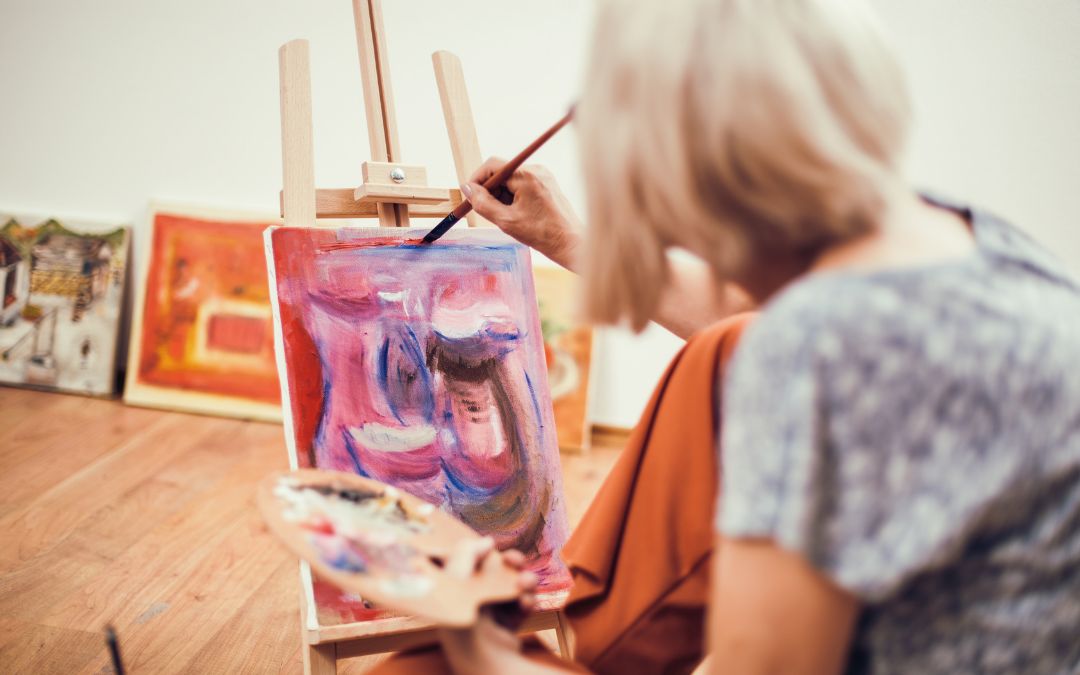Creating new things is a fun, relaxing way for seniors to spend their time, especially for those with dementia. The great news? Even a weekly art class could have added benefits. Studies over the past two decades found that creating art can improve happiness and encourage speech. Plus, it can even boost cognitive function in parts of the brain affected by dementia and Alzheimer’s. This practice is commonly known as art therapy in the senior living and care industry.
You may be asking, what is art therapy, and how does art therapy work? We break down the basics below.
What is art therapy?
Expert therapists at the American Art Therapy Association define art therapy as: “an integrative mental health and human services profession that enriches the lives of individuals, families, and communities through active art-making, creative process, applied psychological theory, and human experience within a psychotherapeutic relationship.”
In simple terms, art therapy allows seniors to express emotion through the things they create. This treatment is extremely beneficial for seniors who might not express themselves verbally. Instead of being locked in their bodies, they’re now allowed to access a new, creative side of themselves.
According to the experts at Daily Caring, the best kinds of art therapy draw on the passions and memories of a senior. If you’re considering art therapy, bear in mind your loved one’s abilities. Try to set them up with a task that stimulates their sense, but one where they can succeed. For example, if they once loved to paint, try an easy watercolor activity. If they need help with hand dexterity and strength, modeling clay is a fantastic place to start.
How does art therapy work for seniors with dementia?
Art therapy can encompass many different mediums, such as painting, drawing, dancing, photography or even scrapbooking. No matter the practice, the therapy allows seniors to express themselves differently. This is because creating art uses a different part of the brain than the part we use when we speak.
In an article for AARP, neurology professor Bruce Miller MD breaks down art therapy’s tangible effects for dementia patients. According to Dr. Miller, “When dementia is localized to the left side of the brain, patients experience progressive loss of language, but tremendous visual creativity can emerge—sometimes painting or sculpture, or occasionally they become obsessed with their gardens. It’s beautiful and sad.” Miller adds that as the brain degenerates, artistic ability can reach a peak before diminishing.
What are the benefits of art therapy for people with dementia?
When it comes to how art therapy works as far as the actual results, research supports an overwhelmingly positive experience. A 2016 study published in Chinese Nursing Research magazine found that art therapy positively affected dementia patients in the following ways:
- Improved cognition: attention, verbal skills, and patient orientation improve as patients immerse themselves in their work. The study cited an experience where dementia patients attended a three-week, ninety-minute art therapy session, which involved looking at masterworks and creating their own art. Patients were encouraged to chat, which increased verbal fluency from 7.3 percent to 25.9 percent.
- Improved behavior and psychological symptoms: according to the study, 70 to 90 percent of patients with dementia suffer from restlessness, anger, depression, anxiety, and sadness as the disease progresses. Researchers suggest that art activities can help regulate mood, as dysfunction in that hemisphere can lead to wildly oscillating emotions. The study saw a small group of dementia patients take an art class coloring. In the weeks following the class, part of the group had decreased scores of wandering and calling nurses for no reason and increased average sleep time from 4.5 hours to 7.9 hours.
Other medical professionals have expanded this research. A 2017 study conducted by the Montreal Museum of Fine Arts, the RUIS McGill Centre of Excellence on Longevity, and the Jewish General Hospital supported these claims. In addition, they found that well-being, quality of life, and health improved for all seniors who took part in a three-month art therapy workshop—with many experiencing immediate improvement.
Flashes of Joy
The real benefit of art therapy? For Kate de Medieros, associate professor of gerontology at Miami (Ohio) University, it’s all about seeing the joy that art brings to patients. In the same AARP article, Medeiros says that art therapy is all about: “meaningful moments… flashes of joy and purpose, however fleeting or small. [Art can] bring people together, make bridges. It’s not about the past or performance. It’s not about what you can’t do but what you can do.”
While there’s no cure for dementia, there are ways to make a loved one’s life (and your life as their caregiver) much better.
Art therapy is just one of the many activities that will be available in our memory care community at your nearest Vineyard community. For more information or to chat through the benefits of art therapy for your senior, get in touch today.

